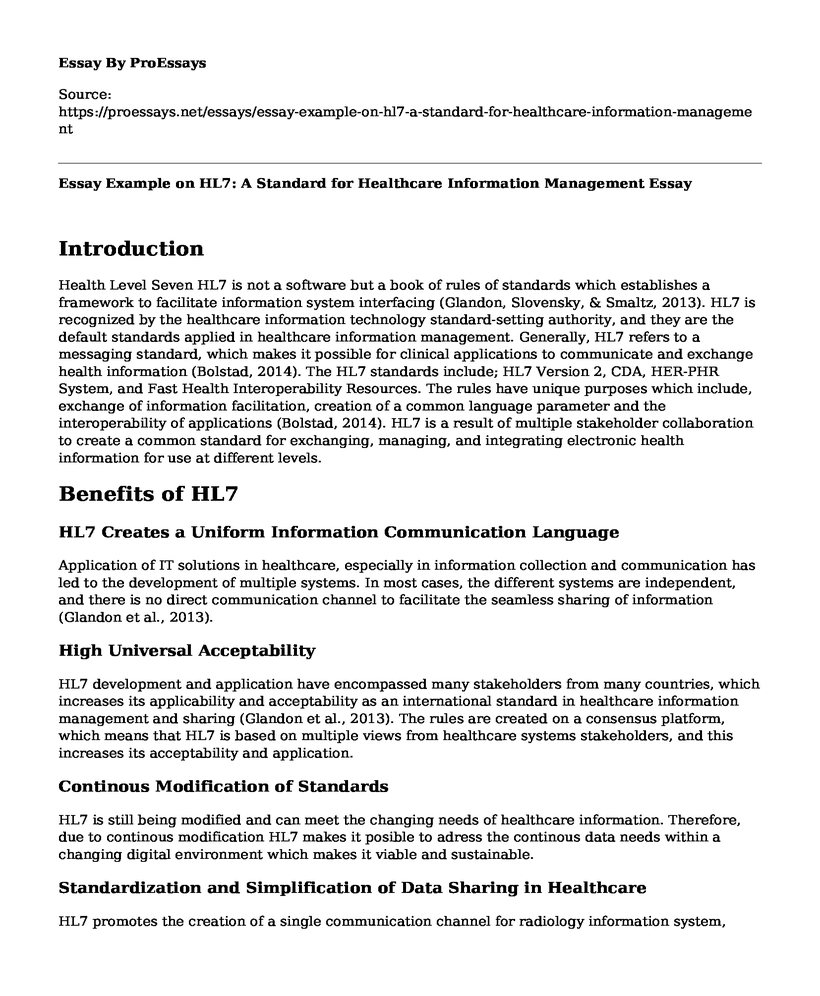Introduction
Health Level Seven HL7 is not a software but a book of rules of standards which establishes a framework to facilitate information system interfacing (Glandon, Slovensky, & Smaltz, 2013). HL7 is recognized by the healthcare information technology standard-setting authority, and they are the default standards applied in healthcare information management. Generally, HL7 refers to a messaging standard, which makes it possible for clinical applications to communicate and exchange health information (Bolstad, 2014). The HL7 standards include; HL7 Version 2, CDA, HER-PHR System, and Fast Health Interoperability Resources. The rules have unique purposes which include, exchange of information facilitation, creation of a common language parameter and the interoperability of applications (Bolstad, 2014). HL7 is a result of multiple stakeholder collaboration to create a common standard for exchanging, managing, and integrating electronic health information for use at different levels.
Benefits of HL7
HL7 Creates a Uniform Information Communication Language
Application of IT solutions in healthcare, especially in information collection and communication has led to the development of multiple systems. In most cases, the different systems are independent, and there is no direct communication channel to facilitate the seamless sharing of information (Glandon et al., 2013).
High Universal Acceptability
HL7 development and application have encompassed many stakeholders from many countries, which increases its applicability and acceptability as an international standard in healthcare information management and sharing (Glandon et al., 2013). The rules are created on a consensus platform, which means that HL7 is based on multiple views from healthcare systems stakeholders, and this increases its acceptability and application.
Continous Modification of Standards
HL7 is still being modified and can meet the changing needs of healthcare information. Therefore, due to continous modification HL7 makes it posible to adress the continous data needs within a changing digital environment which makes it viable and sustainable.
Standardization and Simplification of Data Sharing in Healthcare
HL7 promotes the creation of a single communication channel for radiology information system, health information system, lab information system and the electronic health records seamlessly which is crucial in improving care delivery and also promotes healthcare provider decision making convenience. This makes it easy for healthcare personel and patients to understand healthcare data in a more straight forward language.
HL7 Integrates with all IT Systems
HL7 is a system universal standard which means that healthcare organizations do not need new systems and equipment. This factor ensures that the healthcare organizations does not incur any extra cost to comply with the HL7 rules.
References
Bolstad, J., (2014, October 28). HL7 tutorial part one: What is HL7? Retrieved from https://www.youtube.com/watch?v=ZAgdYR1rmEQ
Glandon, G. L., Slovensky, D. J., & Smaltz, D. H. (2013). Information systems for healthcare management. Chicago. Health Administration Press. 2014
Cite this page
Essay Example on HL7: A Standard for Healthcare Information Management. (2023, Jan 13). Retrieved from https://proessays.net/essays/essay-example-on-hl7-a-standard-for-healthcare-information-management
If you are the original author of this essay and no longer wish to have it published on the ProEssays website, please click below to request its removal:
- Children with Disabilities in Foster Care Systems - Research Paper Examlple
- Research Paper on Prosthodontics Profession
- Role of Terrorism in Homeland Security Paper Example
- Essay Sample on Internet Addiction in College Campuses
- Essay Example on Maximizing Cost Efficiency: The Benefits of Life-Cycle Cost Analysis (LCCA).
- Essay Sample on Ethics in Nursing: A Critical Integral Part of Care
- Free Essay on Strategic Planning and Decision-Making: Navigating the Path to Organizational Success







